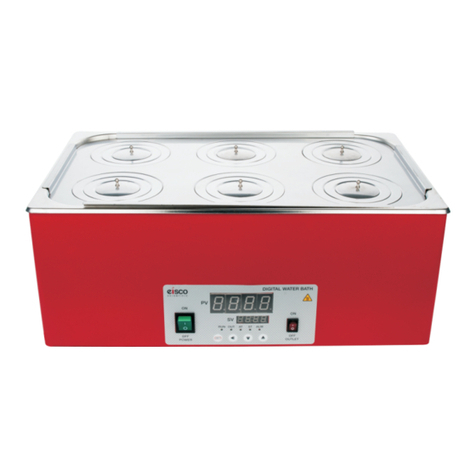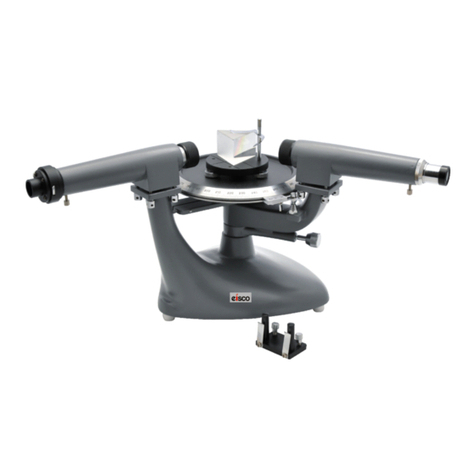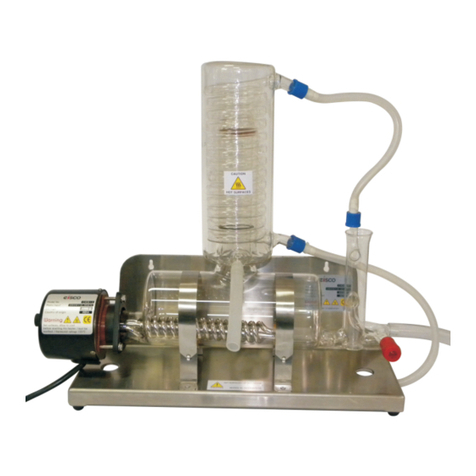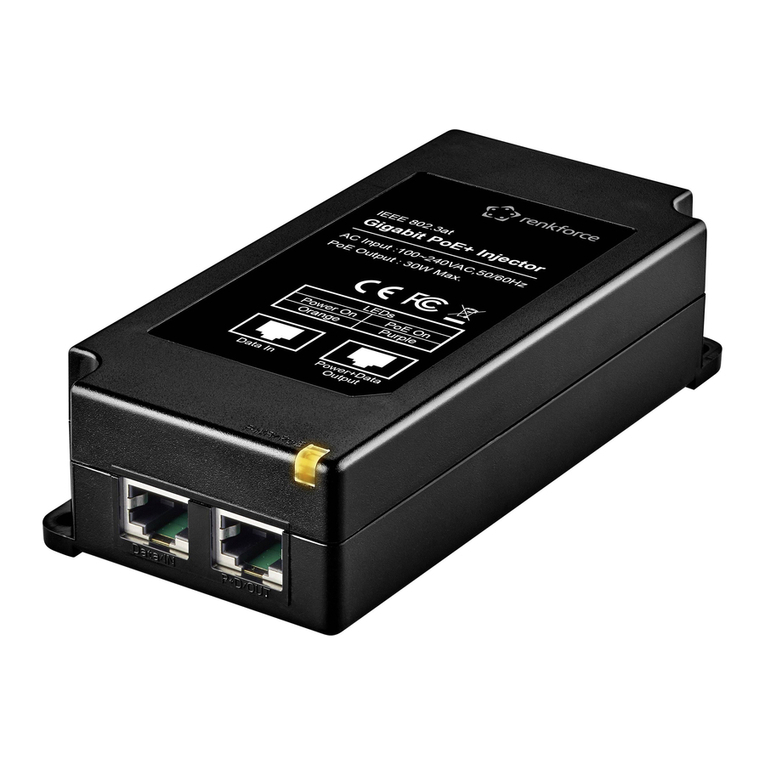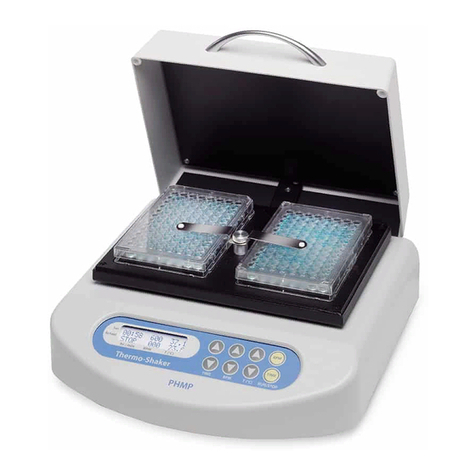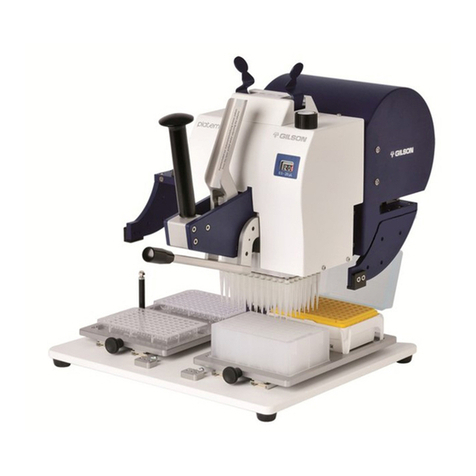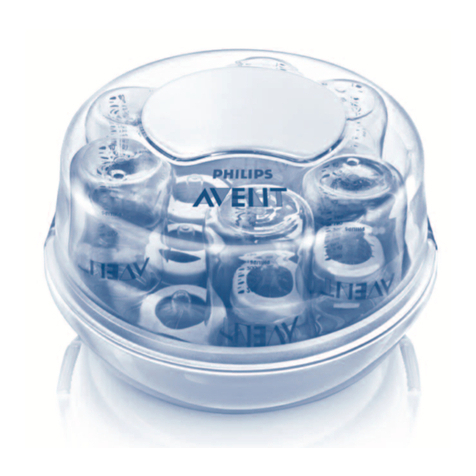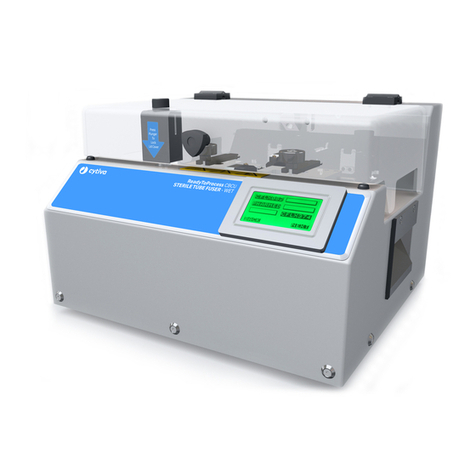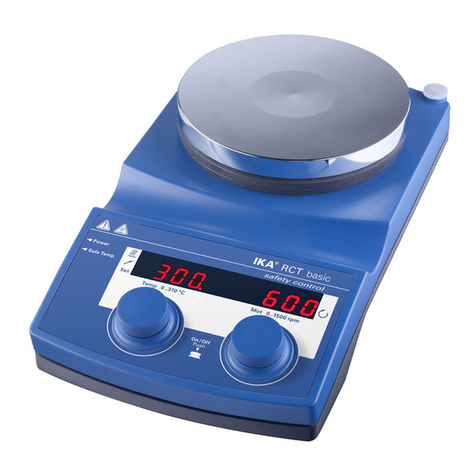Eisco PH0849 User manual

DEMONSTRATION TRANSFORMER APPARATUS
Cat. No. PH0849
Instruction Manual

Page 2 of 7
ãEISCO SCIENTIFIC – www.eiscolabs.com
DEMONSTRATION TRANSFORMER APPARATUS
INTRODUCTION:
This apparatus is designed for supervised student use. Though the projects outlined in this kit
are safe under standard operation, dangerous voltages and currents can be created with
this kit so careful supervision is required. This kit provides means of
• Building a step-up and step-down transformer
• Understanding induction for DC vs. AC voltage
• Investigating the effect of an iron core and iron loop in transformers
CONSTRUCTION and BACKGROUND:
The kit contains 4 coil units and one dissectible iron core unit, with a U-shaped piece, I-shaped
piece, and retaining clamps with stainless steel bars. One coil unit has a 230 VAC 3-pin
connector with an on/off switch. The remaining units all have 4-mm connectors labeled by the
number of coil turns and maximum permissible current.
The coil units can be placed on either the U-shaped or I-shaped iron core. The coil unit to
which power is applied in a circuit is called the primary coil. The other coil is called the
secondary coil.
When power is supplied to the primary coil, magnetic fields are created. An electromotive force
(EMF) is created in the secondary coil in response to the changing magnetic field. Thus, even
though the primary and secondary coil have no electrical connection, they carry an inductive
connection which allows energy to be transferred from the primary to the secondary coil.
Generally speaking, if the secondary coil has more turns than the primary coil, the EMF
induced in the secondary coil will be larger than the primary coil. If the secondary coil has
fewer coils then the induced EMF will be smaller than in the primary coil.
The ratio between the voltages in the primary and secondary coils will be roughly equal to the
ratio of the coils. The actual resistance of some of the coils is very small so extreme care must
be taken is constructing circuits to ensure students and teachers don’t injure themselves or
damage the equipment.
WARNING!
Very large and unsafe voltages can be created
with this kit using even small power supplies.
Extreme care should be taken to avoid dangerous transformer coil combinations.
WARNING!
WARNING!
The components of this kit carry the risk of electric
shock and should be used with extreme caution.
WARNING!

Page 3 of 7
ãEISCO SCIENTIFIC – www.eiscolabs.com
WARNING!
The 3-pin connectorized 230 VAC primary coil
will blow its fuse if turned on without an iron core!
WARNING!
WARNING!
Do not try to place or remove the I-shaped iron core when the primary coil is on!
WARNING!
Required Equipment
A number of accessories are required to explore the concepts in this kit. These parts can be
found on www.eiscolabs.com.
• Center-zero Moving Coil Galvanometer (Eisco model PH1084E)
• Strong Bar Magnet (Eisco model PH0789D)
• Simple switch (Eisco model PH1029F)
• 12V/6A variable AC/DC power supply (Eisco model EPR1330).
• Digital Multimeter (Eisco model PH1121B)
• 4 mm Connecting Leads, quantity 5 (Eisco models PH1055H, red,
and PH1055G, black)
Guide for Student use:
Basic Induction
1) Take the coil unit with 6000 coils and connect it to a center-zero moving coil galvanometer
using connecting leads.
2) Insert a strong magnet in the coil. What happens to the current?
3) With the magnet in the coil what is the current reading?
4) Now remove the magnet. What happens to the current.
5) Try removing the magnet at different speeds? What happens?
The EMF (voltage) induced in the coil is a result of changing magnetic fields. The effect is
stronger if the magnetic field is larger or if the magnetic field changes more quickly.
PH0789D
PH1084E
PH1029F
EPR1330
PH1121B
PH1055H/G

Page 4 of 7
ãEISCO SCIENTIFIC – www.eiscolabs.com
Coil to Coil Induction - DC
1) Take the coil unit with 1200 coils and it directly to a low-voltage DC power supply (a few
Volts should be sufficient) with a simple switch in the off mode.
WARNING!
Ensure that you are using the 1200 coil unit!
The resistance in the smaller coils is very small, allowing
a very large current to be created with even low DC voltages.
USING THE WRONG COIL CAN CAUSE THE CURRENT
TO EXCEED THE CURRENT RATING OF THE COIL.
WARNING!
2) Bring the two coils (1200 and 6000) together so their center holes are lined up. Flip the
switch on. What happens? Flip the switch off. What happens? Can you explain what you see?
3) Turn one of coil units around and cycle the switch again. What has changed? Can you
explain why it changed?
4) With the switch on, pull the coil units away from each other. Bring them back together. What
happens? What happens if you pull them apart quickly? Slowly?
The powered coil creates a changing magnetic field which switched on and off. The changing
magnetic field induces an EMF in the second coil. Flipping the coils reverses the direction of
the magnetic field relative to the coil winding, inducing an EMF in the opposite direction.
Pulling the coils apart and bringing them together changes the magnetic field through the
second coil, causing an EMF.
Coil to Coil Induction - AC
1) Turn off the DC power supply. Switch the connecting leads to the AC outputs on the power
supply.
WARNING!
Ensure that you are using the 1200 coil unit!
The resistance in the smaller coils is very small, allowing
a very large current to be created with even low AC voltages.
USING THE WRONG COIL CAN CAUSE THE CURRENT
TO EXCEED THE CURRENT RATING OF THE COIL.
WARNING!
2) Remove the galvanometer on the 6000 coil unit and replace it with a digital multimeter set to
detect AC voltage.
2) Bring the coils together and turn the power supply and then the switch on. What is different
now?
3) Turn one of the coils around. What changed?
4) Pull the coils apart and bring them back together.

Page 5 of 7
ãEISCO SCIENTIFIC – www.eiscolabs.com
5) How does the voltage of the power supply appear to relate to the voltage in the secondary
coil?
6) Insert the straight iron coil through both coils. What happened to the voltage in the
secondary coil? Write down the voltage in the secondary coil.
The AC current causes a changing magnetic field. This induces a changing EMF in the
secondary coil which follows the AC voltage in the primary coil. The AC-mode multimeter
detects the AC voltage across the coil.
Without the iron core, the strength of the magnetic field falls off quickly, even when the coils
are close together. With the iron core in the coils, the changing magnetic field created by the
primary coil induces a changing magnetization in the iron core. This is similar to the way a
paper clip becomes magnetized when touching a permanent magnet. The magnetized iron
core is able to induce a much stronger EMF in the secondary coil than is possible without it.
Core-mounted Induction
1) Mount both coils on the U-shaped iron core (U-core). Don’t attach the straight iron core (I-
core) yet. Write down the AC-voltage through the secondary coil. How does that compare to
the voltage you wrote down from the last section? Why do you think it is different?
2) Turn off the power supply. Attach the I-core. Turn on the power supply. How has the voltage
changed? Can you explain why the voltage has increased?
3) Loosen the I-core and insert scraps of paper between the I-core and the U-core. How has
the voltage changed?
The magnetization of the U-core decreases at the far end of the U in the secondary coil. This is
similar to the magnetization of several paper-clips in sequence touching a magnet. The farther
away from the source of the magnetic field, the smaller the magnetization. By attaching the I-
core, we are able to magnetize both sides of the U-core equally. Adding pieces of paper
incrementally reduces the ability of the I-core to magnetize the far part of the U-core.
Calculating transformer parameters
When the coil units are mounted on the U-core and I-core is attached, the voltage in the
secondary coil can be calculated by the number of turns in each coil and the voltage across
the primary coil.
!
"#$"
$%
!
%
If the ratio of the secondary to the primary is very large, even small voltages can create
dangerously high voltages.
1) Work with a partner to calculate the voltage reduction/amplification factors in the following
table.

Page 6 of 7
ãEISCO SCIENTIFIC – www.eiscolabs.com
$"
$%
6
30
54
66
72
300
600
1200
2000
4000
6000
6
30
54
66
72
300
600
1200
2000
4000
6000
It turns out that it’s not the voltage which is dangerous – it’s the current. A large enough AC
current can stop your heart and kill you. When you touch a high voltage source, you complete
a simple resistance circuit allowing current to flow across through your body. Exactly how
much current will flow depends upon the contact resistance between your body and the
electrical contact you’re touching. In a lab setting, typical contact resistance of touching an
electrical lead with a wet finger or hand is between
&'(
to
)*'(
. Completing a circuit by
touching an electrical lead with each hand drops the resistance by half – from
)+*'(
to
,+*'(
.
The threshold of pain occurs around 1 mA with AC current and 5 mA with DC current. An AC
current as low as 30 mA can stop your heart after just a few seconds.
The next phase of experiments will use 230 VAC in the primary 600 coil unit.
2) What is the highest secondary voltage achievable using the available secondary coils?
Which coil achieves this?
3) What current would flow through your body if you were touching the output leads of the
secondary coils with wet hands (assume a total resistance of
)+*'(
). What would happen to
you?
4) Work with a partner to fill out the following table of current flow through your body if you
touch the secondary leads with wet hands (total resistance of
)+*'(
). Highlight or circle the
configurations which are painful and cross out the configurations which are dangerous. Have
your instructor sign-off on your findings.
-"#!
"
.#$"
$%
!
%
.
!
%#/&01!23, $%#400, . # )+*'(
$"
6
30
54
66
72
300
600
1200
2000
4000
6000
$"$%
5
!
"
-"

Page 7 of 7
ãEISCO SCIENTIFIC – www.eiscolabs.com
5) Now that we have identified safe transformer configurations, you can explore safe
combinations. Compare the expected voltage to the measured voltage.
!
%#/&01!23, $%#400, . # )+*'(
$"
6
30
54
66
72
300
600
1200
2000
4000
6000
!
"6789:;<8=
U.S. Distributor:
Eisco Scientific
788 Old Dutch Rd.
Victor, NY 14564
Website: www.eiscolabs.com
EISCO SCIENTIFIC instructions, content and design is intellectual property of EISCO
Table of contents
Other Eisco Laboratory Equipment manuals
Popular Laboratory Equipment manuals by other brands
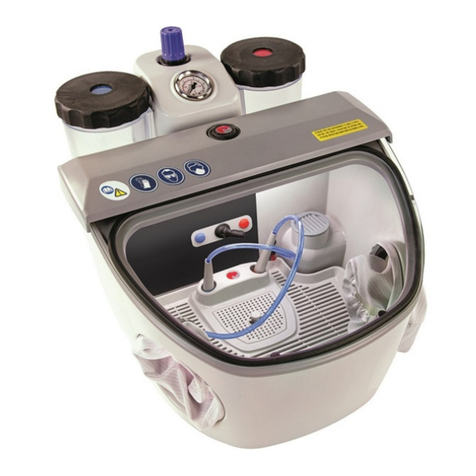
Mestra
Mestra ECLIPSE II MANUAL ORIGINAL
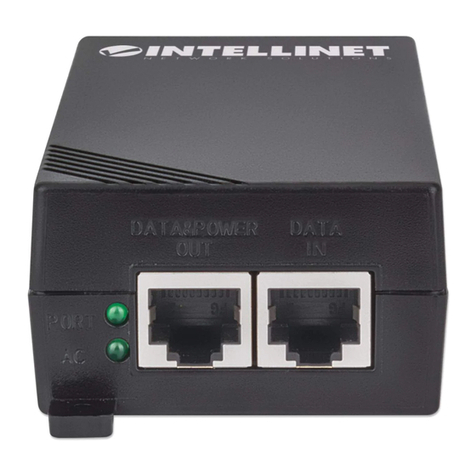
Intellinet
Intellinet 561518 instructions

Cascade Sciences
Cascade Sciences CVO-5 Installation and operation manual

Agilent Technologies
Agilent Technologies 7820A Service manual

HTL
HTL Discovery Pro quick start guide

Chemglass Life Sciences
Chemglass Life Sciences CLS-1445 Series instruction manual
